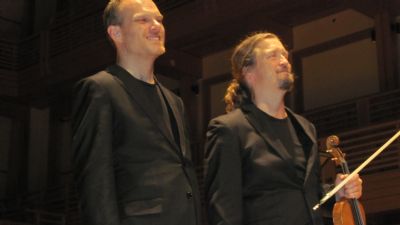|
Symphony
FROM THE NEW WORLD TO THE OLD WORLD
by Peter Lert
Saturday, June 14, 2025
Chamber
MC2 DUO RECITAL CLOSES 222'S SEASON
by Terry McNeill
Saturday, June 14, 2025
Choral and Vocal
CANTIAMO SONOMA'S LUSCIOUS A CAPELLA SINGING IN SEASON ENDING CONCERT
by Pamela Hicks Gailey
Sunday, June 8, 2025
Symphony
SRS SEASON ENDS WITH RESOUNDING TA-TA-TA-BANG
by Terry McNeill
Sunday, June 1, 2025
Symphony
YOUTHFUL VIRTUOSITY ON DISPLAY AT USO'S MAY CONCERTS
by Peter Lert
Saturday, May 17, 2025
Symphony
MYSTICAL PLANETS AND LIVELY GERSHWIN ORTIZ AT FINAL SRS CONCERT
by Peter Lert
Sunday, May 4, 2025
Symphony
VSO'S CONCERT MUSIC OF TIME, MUSIC OF PLACE
by Peter Lert
Sunday, April 27, 2025
VOCAL ELEGANCE AND FIRE AT THE 222'S RECITAL APRIL 26
by Pamela Hicks Gailey
Saturday, April 26, 2025
CANTIAMO SONOMA SINGS AN INSPIRED GOOD FRIDAY MOZART REQUIEM CONCERT
by Pamela Hicks Gailey
Friday, April 18, 2025
DRAMATIC SHOSTAKOVICH SYMPHONY CLOSES PHILHARMONIC'S 25TH SEASON
by Terry McNeill
Sunday, April 13, 2025
|
 |
 Lars Vogt (left) and Christian Tetzlaff Savoring Weill Hall Applause Feb. 18 |
AUTHORITATIVE BARTOK HIGHLIGHTS TETZLAFF VIOLIN RECITAL
by Terry McNeill
Saturday, February 18, 2017
Christian Tetzlaff’s Feb. 18 violin recital rolled along with lively and fresh readings of Mozart, Beethoven and Schubert when the specter of Bartok’s granitic Second Sonata intervened. The sonic shock to the audience of 250 in Weill was palpable.
Composed in 1923 the 20-minute two-movement work is an insistent and often meandering Sonata that demands a lot from the listener, but even more so from a virtuoso executant. Though there are references to the composer’s Piano Sonata of three years later, the Bartok stands by itself in atonality and invention. Mr. Tetzlaff caught the fantasy and rhythmic complexity of the opening molto moderato with accurate slides up to a held note, and long phrases mixed in with a formidable portamento and pizzicato technique. There were no easy tunes to grasp, no legato phrasing and counterpoint.
Sonic outbursts continued in the concluding allegretto with a beginning toccata that was played on top of the strings, often without vibrato, and with solid foundation playing from pianist Lars Vogt. The intangible themes cried out from both instruments, sometimes shrilly, sometimes with surprisingly powerful playing but always under impeccable control. A few in the small Weill audience were seen to lose interest or were simply overwhelmed, but many (perhaps some violinists?) were entranced by the provocative performance, and gave the duo a standing ovation.
Mozart’s F Major Sonata, K. 377, followed the Bartok and was oil on troubled waters. Smiles appeared in the audience as the familiar music unfolded with swirling scales from Mr. Vogt and appropriately fast tempos. It was an outsized reading throughout, and in the variations of the andante each version had a different character, and Mr. Tetzlaff deftly conveyed a slow dance and then rich tone in the charming theme.
Beethoven’s C minor Sonata (Op. 30, No. 2) opened the program with strong instrumental contrasts and outsized, if often clipped, phrases. Mr. Tetzlaff’s subtle control of dynamics was especially present in the lovely adagio where every register of his violin sounded pure, and intonation dead on. At one point he stroked twice across all four strings with the backside of his hand, producing a beguiling chordal effect. The chirpy scherzo led to a concluding allegro presto of substantial momentum, where color and articulation from Mr. Vogt took a back seat to often raw but exciting “middle period” Beethoven playing.
Schubert’s brilliant B Minor Rondo (D. 895) ended the program in heated salonstücke romp that was lengthy and repetitive, as Schubert often is, but also brought the audience again to its feet in applause.
The one encore was a special choice, the Ballada from Janácek’s 1913 Violin Sonata. Here Mr. Tetzlaff and Mr. Vogt explored the fluid chromatic runs with deliberate tempos and a long line that produced for the first time during the evening’s recital calming and shimmering effects. This was ensemble playing of a high order.
In some ways the selected works were a curious mix, neither for connoisseurs nor the gallery. But there was no mistaking Mr. Tetzlaff’s singular achievement and consummate command.
|

